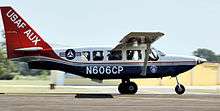GippsAero GA8 Airvan
| GA8 Airvan | |
|---|---|
_just_after_taking_off_from_Illawarra_Regional_Airport.jpg) | |
| Gippsland Aeronautics GA-8 Airvan | |
| Role | Utility aircraft/Transport |
| National origin | Australia |
| Manufacturer | GippsAero |
| First flight | 3 March 1995 |
| Introduction | December 2000 |
| Primary user | United States Civil Air Patrol |
| Produced | 2000–present |
| Number built | 210+[1] |
| Variants | Gippsland GA10 |
The Gippsland GA8 Airvan is a single-engined utility aircraft manufactured by GippsAero (formerly named Gippsland Aeronautics) of Victoria, Australia. It can seat eight, including the pilot.
Development



The aircraft was designed to fill a market niche perceived by the manufacturer between the Cessna 206 and Cessna 208 models, with seating for four and up to fourteen passengers respectively.[2] It is used in various roles, including passenger services; freight; sightseeing; parachuting; observation and search and rescue.
As of June 2013, 200 Airvans had been produced and delivered.
A turbocharged version of the aircraft was in planning from 2004, and the prototype turbocharged aircraft commenced flight testing in October 2006. In February 2009, Gippsland Aeronautics announced that the Australian Civil Aviation Authority had issued an amendment to the GA8 type certificate to cover the turbocharged variant. This version is designated as the GA8-TC320 and is powered by a 320 HP Lycoming TIO-540-AH1A Turbocharged Fuel Injected Engine. The first deliveries took place in February 2009, with several GA8 TC-320 Airvans delivered to customers in Australia and New Zealand.[3]
A turboprop derivative of the GA8, the GA10, is also being developed. It is a slightly stretched 10-seat capacity aircraft powered by a Rolls-Royce 250-B17F/2 turboprop engine.[4] It is planned to retain as many common parts with the GA8 as possible.
A floatplane version has also been considered by the manufacturer.[5]
In December 2010, a Supplemental Type Certificate (STC) was issued to the manufacturer for a 200 lb. increase in MTOW.
At EAA Oshkosh 2014, the GA8 Airvan was officially renamed as Mahindra Airvan 8.[6]
Operational history
One GA8 Airvan, VH-BYI, became the first Australian designed and manufactured aircraft to fly around the world, raising funds for malaria awareness. It was piloted by Australian pilots, Ken Evers and Tim Pryse, who took off from Bendigo, Victoria, Australia on 8 May 2010. After flying 27,675 nautical miles for over 263 flight hours and burning over 16,000 litres of Avgas, the two men returned to Bendigo 62 days after take-off, landing at 2:33pm on 10 July 2010.[7][8] Their flight took them through several malaria endemic countries, and their charity "Millions Against Malaria" continues to work in malaria-plagued areas such as Papua New Guinea.[9]
Operators

Civil
The GA8 is popular with air charter companies, skydiving operators and small feeder air carriers. Larger operators include the US Civil Air Patrol which flies 18 Airvans for Search and Rescue operations, of which 16 carry the Airborne Real-time Cueing Hyperspectral Enhanced Reconnaissance (ARCHER) system, which can be used to search for aircraft wreckage based on its spectral signature. Mission Aviation Fellowship Australia operates eleven Airvans, providing air-transport services in developing countries.[10]
Military
Specifications


Data from Jane's All The World's Aircraft 2003–2004[12]
General characteristics
- Crew: 1
- Capacity: 7 passengers
- Length: 8.95 m (29 ft 4 in)
- Wingspan: 12.28 m (40 ft 3 in)
- Height: 3.89 m (12 ft 9 in)
- Wing area: 19.32 m2 (208.0 sq ft)
- Aspect ratio: 7.9:1
- Empty weight: 997 kg (2,198 lb)
- Max takeoff weight: 1,814 kg (3,999 lb)
- Fuel capacity: 340 L (74.8 Imp Gallons)
- Powerplant: 1 × Textron Lycoming IO-540-K1A5 air-cooled flat-six, 220 kW (300 hp)
- Propellers: 2-bladed Hartzell F8475R constant speed propeller
Performance
- Maximum speed: 241 km/h (150 mph; 130 kn) at 1,525 m (5,000 ft)
- Cruising speed: 222 km/h (138 mph; 120 kn) at 3,050 m (10,000 ft)
- Stall speed: 97 km/h (60 mph; 52 kn) (flaps down)
- Range: 1,352 km (840 mi; 730 nmi)
- Endurance: 6 hr
- Service ceiling: 6,100 m (20,013 ft)
- Rate of climb: 4.00 m/s (788 ft/min)
See also
- Related development
- Aircraft of comparable role, configuration and era
References
- Notes
<div class="reflist references-column-width" style="-moz-column-width: 30em [4]; -webkit-column-width: 30em [4]; column-width: 30em [4]; list-style-type: decimal;">
- ↑ Arbon, Tony (May 2015). "Register Review". Australian Aviation. Manuka ACT: Phantom Media (326): 94.
- ↑ Wallace, Lane (7 May 2005). "Flying Magazine, May 2005". Flyingmag.com. Retrieved 2011-02-15.
- ↑ "GA web site". Gippsaero.com. Retrieved 2011-02-15.
- 1 2 3 4 "GippsAero's GA10 project on track". Australian Flying. 3 March 2011. Retrieved 9 July 2011.
- ↑ "GA News Media Archives". Gippsaero.com. Retrieved 2011-02-15.
- ↑ "Mahindra floats US assembly for rebranded Airvan". Flightglobal. 30 July 2014. Retrieved 4 August 2014.
- ↑ "The Flight". Millions Against Malaria. Retrieved 26 December 2014.
- ↑ "Mahindra GippsAero GA8 TC 320 Airvan makes maiden landing in Mumbai". India Infoline News Service. 21 February 2011. Retrieved 10 July 2011.
- ↑ "Millions Against Malaria -". Millions Against Malaria. Retrieved 26 December 2014.
- ↑ "MAF web-page". Maf.org.au. 5 May 2010. Retrieved 2011-02-15.
- ↑ "GippsAero". GippsAero. 18 March 2004. Retrieved 2011-02-15.
- ↑ Jackson 2003, p. 6.
- Bibliography
- Jackson, Paul (2003). Jane's All The World's Aircraft 2003–2004. Coulsdon, UK: Jane's Information Group. ISBN 0-7106-2537-5.
External links
| Wikimedia Commons has media related to Gippsland GA8. |
- Gippsland Aeronautics Official Site
- GA October 2006 newsletter
- CASA Australia Type Certificate and Type Certificate Data Sheet
- FAA Type Certificate Data Sheet
- Specs & Photo at Flugzeuginfo.net